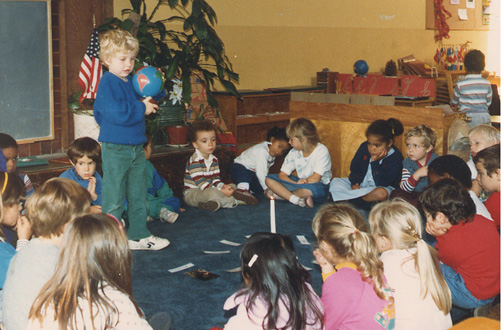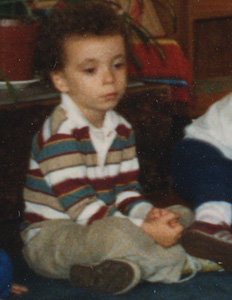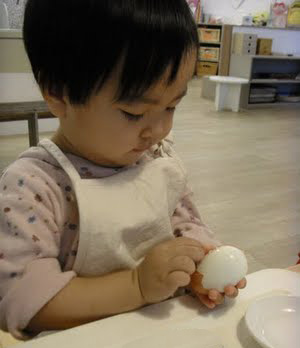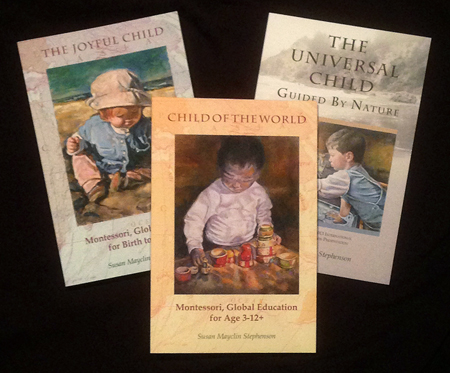| CONCENTRATION Where the magic happens! Montessori Newsletter for Parents and Teachers, #18 to view in your browser: News | ||
|---|---|---|
 Forward to friends | ||
As I was scanning this picture of a lovely Montessori 3-6 birthday party celebration and looking at it on the computer screen I could see for the first time the look of complete boredom on the faces of the children who had been pulled away from concentrating on their individual work to "celebrate." I did the math: 30 children x 3 years in the class = 90 birthdays! This brought home to me the reason why there are no "required" group or collective lessons, no regular "circle" time, in authentic Montessori classes.
Yes, concentration on individual work is where the magic happens.
When work and concentration on activities appropriate for the child's stage of development are protected the potential for optimum development is seen in ways previously not thought possible. A human being is revealed who knows that happiness does not come from things or fame, who exhibits a love of silence, a natural impulse to do good work, to learn, and to help others. This is the magic of Montessori.
| ||
 |  |  |
The greatest sign of success for a teacher is to be able to say,
"The children are now working as if I did not exist." —Maria Montessori, MD
This means children are so busy concentrating they don't notice where the teacher is! To help a teacher change from the traditional collective lessons, to the Montessori 1:1 lessons and protection of concentration, Dr. Montessori developed the following observation tool. It tracks the developing concentration ability of a child over the period of 3 hours each morning. This 3-hour work period is free of any scheduled activities such as "circle time", group outside play, group snack, specialist teacher giving lessons, etc. More on these work curves or graphs can be found in The Advanced Montessori Method, Volume I.
| ||
 |  | ||
| This is the description of the "work curve" (sometimes called "concentration graph"). The middle line is neutral, above the line is work/order/concentration, below the line is disorder/disruption. The actual graph used by the teacher would be blank except for the time at the bottom, the name of the child and date. | All of these graphs are taken from Dr. Montessori's book "The Advanced Montessori Method, Vol. I". It is normal in a child who is just beginning to attend the Montessori class to exhibit disturbing behavior, to interrupt others who are concentrating, and to be unable to focus on anything for long. | ||
 |  | ||
| This child is not disrupting. He is beginning to focus and is on the way to what is called "normalization", or the ability to concentrate and be happy. However he is only working on activities for a short period of time, and many different activities in this 3-hour work cycle. | This child enters the class and settles on work right away, reaching a high level of concentration. Notice that "contemplation" is clearly considered concentration. If a child is thinking, and not interrupting others, he should not be interrupted. | ||
  | Concentration: Valuable, spontaneous concentration occurs in many ways, but it does not include screen time. Montessori "work" is fun, the child's choice. Sometimes it is called "play" just because it is so enjoyable. It includes physical activity—of the whole body and the hands—work on real "practical life" activities, dance, art, music, and these skills combined with projects in academic subjects. Love: Providing for and supporting this deep need of the child is an act of love on the part of the parent, grandparent, or teacher. | ||
MONTESSORI BLOGCONCENTRATION BEGINS IN THE VERY EARLY YEARS. HERE ARE SOME EXAMPLESFrom the blog of the author of this newsletter: BIRTH - 3 YEARS    | |||
CONCENTRATION QUOTES FROM MARIA MONTESSORI, MD
| |||
| From Creative Development in the Child, The Montessori Approach, Volume II”(Page 207-208) (Speaking of a lesson) This presentation is given, not to a group of children, but individually, to help the child to grow mentally. We prepare this special environment to help his growth, to offer him freedom so that he can proceed with his work in a normal way. The collective lessons are given only to the child who has not yet been normalised. After normalisation each child grows individually, in his own way. One child may be ready for the lesson one day and another child another day. . . . If we give a lesson we do not command all the children to stop what they are doing in order to listen. Many children may have absolutely no interest in the lesson and we may bore them. From Creative Development in the Child, The Montessori Approach, Volume II”(Page 296) (In a letter from one of Dr. Montessori’s students working in France, after Dr. Montessori had suggested, when she was just beginning to learn about the importance of individual lessons and still was suggesting collective lessons) It is marvelous to see how these children work. They work by themselves, and they are occupied the whole morning. The only thing at which I do not succeed is in interesting them in a collective lesson.
From The Child, Society and the World (Page 15)
A child who concentrates does not disturb others.The teacher must recognize the first moment of concentration and must not disturb it. The whole future comes from this moment and so the teacher must be ready for non-interference when it occurs.
This is very difficult because the teacher has to interfere at every moment before the children are normalized. Generally teachers interfere when a child is working. They go to see what they are doing and praise them. This praise is an interference. The teacher goes to correct mistakes; this is an interference, even though it is an interference of good will.
It is not interference to interfere when the child is naughty but this is just when Grown-ups often say, "Oh the child is so full of life", whereas when the child is working seriously they will often go and say "What are you doing? Show me". Then the concentration is broken; it finished. So never interfere when a child is working by himself.
Don't be preoccupied about whether he is making mistakes, you must not correct him at this moment. The important thing is not that the child should handle the material, but that this material has attracted the attention of the child.
The child corrects himself through repeating the exercise, through the control of error which is exact for some of the material. If you interfere, a child's interest finishes, the enchantment of correcting himself is broken. It is as though he says "I was with myself inside.You called me and so it is finished. Now this material has no more importance for me". A child does not need praise; praise breaks the enchantment. It is a great inner energy, normality, which comes, and you break this if you interfere.
| From Education and Peace (Page 80) A three-year-old child given a cylinder block fitted the ten cylinders into their holes more than forty times and was so oblivious to his surroundings as he did so that he did not even notice external stimuli. This concentration is undoubtedly a means of development.
From The Child in the Family (Page 32)
I observed these same manifestations many more times. When the children had completed an absorbing bit of work, they appeared rested and deeply pleased. It almost seemed as if a road had opened up within their souls that led to all their latent powers, revealing the better part of themselves. They exhibited a great affability to everyone, put themselves out to help others and seemed full of good will. It was clear to me that the concept of order and the development of character, of the intellectual and emotional life, must derive from this veiled source. Thereafter, I set out to find experimental objects that would make this concentration possible, and carefully worked out an environment that would present the most favorable external conditions for this concentration. And that is how my method began. From The Secret of Childhood (Page 156) (In comparing real activities, such as care of the self, the environment, etc., that the child has seen being carried out in the home from birth on, with traditional materials for children) Children are given toys with which they can play, but which create illusions and afford no real and productive contact with reality. Toys furnish a child with an environment that has no particular goal and, as a consequence, they cannot provide it with any real mental concentration but only illusions. They can stir up a child's activity like a puff of air that rouses a tiny flame concealed beneath the ashes of a fire. But the flame is soon spent and the toy is soon thrown away. And yet toys are the only outlets that adults have found for a child's voluntary activity like a puff of air that rouses a tiny flame concealed their toys and believe that a child finds his happiness in them. (On real activities and Montessori materials in school, Page 114) He fixes his whole attention intently upon it and continues to work without a break in a remarkable state of concentration. After the child has finished his work, he appears satisfied, rested, and happy. It was this feeling of rest and satisfaction that I first read on those small, peaceful countenances and in those eyes gleaming with the contentment of a voluntary task completed. The objects which I gave the children were like the key to a clock, but with a significant difference. After it is wound a clock continues to run by itself, and after a child is given an object to use, he not only continues to work with it, but his efforts leave him mentally stronger and healthier than before. (Page 120) Similar events kept recurring, and every time children emerged from such an experience, they were like individuals who had rested. They were filled with life and resembled those who had experienced some great joy. | ||
 |  | ||
AN EXAMPLE OF A DAY IN A 3-6 CLASS WITHOUT GROUPS
Even though there are no regularly scheduled group or collective lessons in authentic Montessori classes, groups are spontaneously formed in several ways including the beginning of a new class (where group lessons occur all day long as children learn to act independently, gradually the time between collective lessons increasing until the whole class is functioning independently), several new children joining a class at the same time, a teacher beginning to read to a child and a few others join in, a child gathers a few friends for a vocabulary game, occasionally a "going home" group as children await their parents, the 5 Great Lessons given in the beginning of a 6-12 class year, children in the 6-12 class group forming a group to plan a research project which often will be a group presentation to the rest of the class. But the interrupted 3-hour work period always takes precedence and no one is required to attend a group activity.
This way of teaching requires a very high level of teacher training in order to know what child is ready for what lesson, and to be able to give that lesson without referring to a book or notes. In my AMI training this ability came partly from the hundreds of hours of practicals (practice giving lessons to fellow students and discussing the purpose, age, level of development, etc. for each one) under the supervision of the teacher trainer.
Here is an example of a typical, no-group, morning in the children's class at the Maria Maria Montessori Institute (MMI) training center in Hampstead, London.Observation
|
ALTERNATIVE USES OF MONTESSORI
The 3-hour work period, deep concentration, normalization, the "miracles" —that amazed the world in the first Montessori Casa dei Bambini in Rome over 100 years ago, and occurs in many places today—will not occur in classes where the teacher is untrained or incompletely trained (taking a correspondence or short training course) or for some reason is not able to carry out what she learned in a full training course. But there can still be benefits.In the class pictured above the non-Montessori-trained teacher is using Montessori material, a geometric solid, to explain a concept to students in a traditional class in Bhutan
| ||
MICHAEL OLAF BOOKS AND DVD'S
After reading or watching these simple introductions many people find it easier to grasp Dr. Montessori's deep and insightful writings. For Dr. Montessori's books, we recommend the translations created by the Montessori family: montessori-pierson
Inside pages and more information about the DVD's are at the Amazon site:The Joyful Child; Montessori, Global Wisdom for Birth to Three Amazon Child of the World: Montessori, Global Education for Ages 3-12+ Amazon The Universal Child, Guided by Nature AmazonDVD: The Wonderful Two's, Montessori Infant Communities in Japan and USAAmazonDVD: Grazie Silvana, Montessori Assistants to Infancy Amazon Here is the Michael Olaf Publishers site for all of these books and DVD's and Montessori educational materials for Birth to Age 7 Years: Michael Olaf  |
FACEBOOK PICTURES AND POSTINGS
If you are on Facebook, you can see pictures from Susan's Montessori work, and more information related to Montessori, on these FaceBook pages:
Susan Mayclin Stephenson The Michael Olaf Montessori Company The Joyful Child Montessori Company Montessori Assistants to Infancy Montessori Homeschooling
List of previous Michael Olaf Newsletters:
#2 Montessori Art, January 2010 #3 Montessori Cultural Geography, May 2010 #4 Montessori Parenting/Teaching, August 2010 #5 Montessori Home Environment, November 2010 #6 Montessori in Sikkim, January 2011 #7 Montessori Math, April 2011 #8 All 2009-2011 Newsletters, May 2011 #9 Montessori Grace and Courtesy, August 2011 #10 Montessori Biology, May 2012 #11 Practical Life, Real Life, Aug 2012 #12 Happy Children for the Holidays, Dec 2012 #13 Book, Child of the World, Mar 2013 #14 Book, The Joyful Child, July 2013 #15 Book, The Universal Child, October 2013 #16 Montessori Language, April 2014 #17 Swaddling, Caring for Others, Authentic Montessori. November 2014
LINKING & SHARING THIS NEWSLETTER You may link this newsletter to any website or to share it in any way
SEE BELOW FOR NEWSLETTER SIGN UP | ||

No comments:
Post a Comment